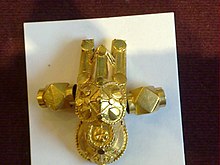Kongu Vellalar
Kongu Vellalar is a sub-caste of Vellalar community found in the western region of Tamil Nadu, which is known as Kongu Nadu. The Kongu Vellalar were classified as a Forward Caste (General class) at the time of Indian independence but they successfully requested to be reclassified as a Backward Class in 1975.[1]
| Kongu Vellalar | |
|---|---|
| Classification | Backward Class |
| Languages | Tamil (Kongu Tamil) |
| Country | India |
| Original state | Tamil Nadu |
| Related groups | Vellalar |
Etymology
The Vellalar of the Kongu country came to be known as Kongu Vellalar. They are also known by names such as Bupaalan, Kudiyaanavar and Vivasaayi, and use the title Gounder as a caste appellation in their personal names.[2]
Origin
According to the Kongu Vellalar Puranam, a 19th century work by Mahavidwan Kandasamy Kavirayar, the Vellalar of the Kongu country trace their origin to Marabalan, a mythical figure who was created from the river Ganges to rid the world of hunger. Marabalan turned to agriculture and his descendants became the Vellalar. Marabalan had various titles such as Gangavamsa, Devar, Vellalar, Bubalan, etc.[3][4]
History
The Kongu Vellalar were inhabitants of the Kongu country since at least the 10th century CE.[5] The Vellalars of Kongu region came to be known as Kongu Vellalar or Gounder, though both the names have also been treated separately in some regions.[6] According Beck's (1972) study, the Kongu Vellalar are one of the top ranking castes who were entited to ownership over land. They followed a kingly model acquiring prestige by ownership of land, control of daily labor and production activity.[7]
The community plays a significant role in the political and economic life of the Kongu Nadu region.[8][9]
Caste structure
The caste is divided into a number of exogamous clans called Kootams.[10] Medieval poet Kambar is said to have given their kula and gotra (kin and clan).[11]
Culture
Wedding
The community has its own style of marriage ceremony. The ceremony is led by person called an Arumbukarar or Arumaikkarar.[12] A long song composed by a Poet and Tamil Saint Kambar, called "Mangala Valthu", is usually sung.[13] In the wedding ceremony, the brother of the bride and sister of the groom play significant roles.[14]
Thaali

A Mangala Sutra is a necklace that the groom ties around the bride's neck in the Indian subcontinent, in a ceremony called Mangalya Dharanam, which identifies her as a married woman.[15] It is called, thaali (தாலி), maangalyam (மாங்கல்யம்) in Tamil.
References
Citations
- Prasad, K.V. (8 May 2009). "Looking to create a Kongu stronghold". The Hindu. Retrieved 22 May 2016.
- Rajannan, Busnagi; India), Institute of Kongu Studies (Salem (1992). Salem cyclopedia: a cultural and historical dictionary of Salem District, Tamil Nadu. Institute of Kongu Studies. p. 340.
- "Purana of Kongunadu's conventional farming". The Indian Express. Retrieved 9 July 2020.
- V. Manickam, p. 540
- Busnagi Rajannan, Institute of Kongu Studies (Salem, India). Salem cyclopedia: a cultural and historical dictionary of Salem District, Tamil Nadu. Institute of Kongu Studies, 1992. p. 5.CS1 maint: multiple names: authors list (link)
- Ramaswamy, Vijaya (2007). Historical Dictionary of the Tamils. Scarecrow Press. p. 303. ISBN 9780810864450.
- Sharad Chari, p. 315
- Gounder consolidation could pose headache to major parties – Times Of India
- Menon, Jaya (15 February 2011). "Rahul keen to test western belt". The Times of India. Retrieved 22 May 2016.
- Gunasekaran, p. 41
- Gunasekaran, p. 27
- Beck, Brenda (1972). Peasant Society of Konku: A Study of right and left subastes in South India. University of British Columbia Press, Vancouver. p. 299. ISBN 0-7748-0014-3.
- Sundaram, B. Meenakshi (20 September 2015). "Kambar, Kongunadu's Friend or Foe?". New Indian Express. Retrieved 12 September 2016.
- Beck, Brenda (1972). Peasant Society of Konku: A Study of right and left subastes in South India. University of British Columbia Press, Vancouver. p. 240. ISBN 0-7748-0014-3.
- Subhamoy Das. "Mangalsutra Necklace – Hindu Symbol of Love & Marriage". About.com Religion & Spirituality. Archived from the original on 13 May 2016. Retrieved 8 May 2016.
Bibliography
- S. Gunasekaran (2017). Vijaya Ramaswamy (ed.). Migrations in Medieval and Early Colonial India. Routledge, 2017.
- V. Manickam (2001). Kongu Nadu, a History Up to A.D. 1400. Makkal Veliyeedu, 2001.
- Sharad Chari (2004). Fraternal Capital: Peasant-workers, Self-made Men, and Globalization in Provincial India. Stanford University Press, 2004.